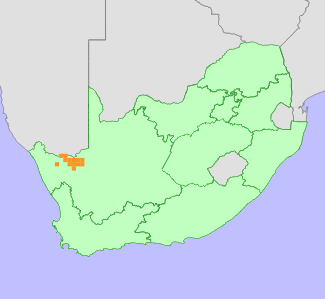|
Scientific Name | Conophytum praesectum N.E.Br. |
Higher Classification | Dicotyledons |
Family | AIZOACEAE |
Synonyms | Ophthalmophyllum praesectum (N.E.Br.) Schwantes |
National Status |
Status and Criteria | Endangered A4cd |
Assessment Date | 2021/12/02 |
Assessor(s) | A.J. Young, P.G. Desmet, I. Ebrahim, D. Guo, A. Harrower, L. Jabar, L. Knoetze, C. Rodgerson, P.C.V. Van Wyk & N.N. Mhlongo |
Justification | This succulent species is endemic to the Northern Cape province of South Africa with an extent of occurrence (EOO) of 5,368 km2 and area of occupancy (AOO) of 116 km2. The population is in decline due to illegal collection for the ornamental succulent plant trade, with more than 19,000 mature individuals confiscated from poachers since 2019. Collection is likely to increase as there has been a dramatic increase in the number of species and volume of plants targeted since 2019. The continued threat of illegal collection is therefore regarded as very high for this particular species. However the plants can be cryptic in nature due to their semi-subterranean habit and are dispersed as isolated plants or small colonies across a wide, often featureless, area. This is suspected to limit the decline to between 50 and 75% of the population within the next three generations (90 years). It therefore qualifies as Endangered under criterion A4. |
Distribution |
Endemism | South African endemic |
Provincial distribution | Northern Cape |
Range | This species is endemic to the Northern Cape province of South Africa. |
Habitat and Ecology |
Major system | Terrestrial |
Major habitats | Aggeneys Gravel Vygieveld, Bushmanland Inselberg Shrubland, Eastern Gariep Rocky Desert, Namaqualand Klipkoppe Shrubland |
Description | This species is widespread across several vegetation units in the Richtersveld and Gariep Desert bioregions in the eastern extent of the Nama-Karoo Karoo and Desert biomes. It is typically found in partial shade (e.g., beneath larger shrubs) on low granite ridges and in rubble.
This species has a generation length of 30 years. It is expected to be sensitive to the impacts of climate change as it does not disperse and while adapted to arid conditions, is dependent on limited seasonal rainfall. Species in the genus are sensitive to long periods of drought. Drought related mortality has been observed for other closely related taxa within the genus. |
Threats |
| Plants have been subject to illegal collection of mature individuals for the international trade in ornamental succulents with several thousand plants being removed since 2019. This species has been highly sought after by collectors and is highly likely to remain so in future. As a result a population decline of 50-75% is suspected over three generations (90 years).
Anthropogenic climate change is a long-term threat to this species. Loss of vegetation cover has been observed across the geographic range occupied by this species via Landsat imagery between 1984 and 2018 indicating a decline in habitat quality. Climate models for the likely emission scenarios where emissions stay at present day levels (RCP 2.6) (Hausfather and Peters 2020) and worst case scenarios where emissions continue to increase during the 21st century (RCP 8.5) indicate that there will be a loss of suitable bioclimatic envelope of between 20% and 87% by 2080 for this species. However, as this taxon possesses certain morphological traits likely to afford resilience to xerophytic conditions and is found across several vegetation units it is expected to have a level of resilience to climate change and the expected population loss is reduced by 20% to negligible levels. Species in this genus have limited dispersal ability and migration to suitable habitats elsewhere is regarded as highly unlikely.
Mining represents a localised threat to some subpopulations. |
Population |
It is difficult to properly assess the population size of this succulent due to lack of data and challenges with the identification of this species. The total number is likely to be between 100,000 and 150,000 mature individuals spread across numerous subpopulations. The population is in decline due to illegal collection for the ornamental succulent plant trade. At least 19,000 plants have been removed from habitat between 2019 and the end of 2021 based on confiscation records, with many more having likely been removed but not intercepted by law enforcers.
|
Population trend | Decreasing |
Assessment History |
Taxon assessed |
Status and Criteria |
Citation/Red List version | | Conophytum praesectum N.E.Br. | Least Concern | Raimondo et al. (2009) | | Conophytum praesectum N.E.Br. | Lower Risk - Least Concern | Victor (2002) | | Conophytum praesectum N.E.Br. | Insufficiently Known | Hilton-Taylor (1996) | |
Bibliography |
Hammer, S. 2002. Dumpling and his wife: New view of the genus Conophytum. EAE Creative Colour, Norwich.
Hammer, S.A. 1993. The genus Conophytum: A conograph. Succulent Plant Publications, Pretoria.
Hausfather, Z. and Peters, G.P. 2020. Emissions - the 'business as usual' story is misleading. Nature 577(618-620).
Opel, M.R. 2004. The rediscovery of Crassula alcicornis. Haseltonia 10:38-40.
|
Citation |
| Young, A.J., Desmet, P.G., Ebrahim, I., Guo, D., Harrower, A., Jabar, L., Knoetze, L., Rodgerson, C., Van Wyk, P.C.V. & Mhlongo, N.N. 2021. Conophytum praesectum N.E.Br. National Assessment: Red List of South African Plants version . Accessed on 2025/07/26 |
 Comment on this assessment
Comment on this assessment


